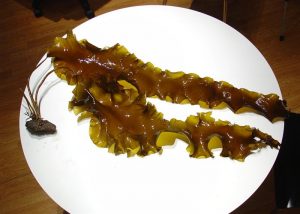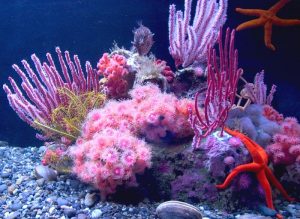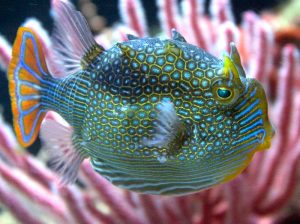Many of the dynamic and truly awesome forces that govern our planet’s oceans virtually escape the attention of many tropical marine aquarists, who are preoccupied with replicating the relatively stable conditions that prevail in waters along the equator. The current popularity of the coral reef aquarium hobby is certainly understandable, given the consistent availability and variety of interesting and beautiful livestock. A surge of technological and philosophical advancements in this field has placed the feasibility of success well within the reach of even casual hobbyists. As these advancements were born of many woeful and expensive failures, it is further understandable why so many of us would adhere to the comfort of reliable methodologies– especially those methodologies that permit the seamless captive cohabitation of creatures from many distant points along the globe.
Nevertheless, a considerable number of aquarists have grown tired of the usual “hodge-podge” aquarium community, as evidenced by the emerging prevalence of biotope aquaria. These inspired individuals are breaking out of comfort zones and (to some degree) abandoning the freedom of choice to create exclusive (if not complete) representations of singular biological communities. Whether this trend leads to or arises from an increasing awareness of the great diversity of marine habitats, it will challenge us firstly to approach aquarium parameters as something to not merely control but to understand, and secondly to view our creatures not merely as ornaments or specimens but as functional placeholders from distinct (albeit tightly interconnected) habitats. A conceptual transition of this kind could produce a more competent and conscientious generation of hobbyists– even while making the marine aquarium hobby itself a hell of a lot more interesting.
On account of its youth, the biotope aquarium school is not without a whole lot of disoriented terminology. A markedly provincial use of the term “biotope” is commonly applied to any other than the bread-and-butter tropical marine reef or “fish-only” tank. A notable example of this can be found in the wholesale grouping of temperate marine aquaria into a single, novel, indivisible niche. This particular misapplication of the term can be explained only by the simple fact that tropical aquaria are the established norm. For the purpose of sweeping ecotypes into broad categories, tropical reef environments (owing to their relative uniformity) arguably better fit the bill as ubiquitous biotopes! In any case, though temperate marine environments undoubtedly contain a comparatively lower species diversity, they represent a higher habitat diversity– and so provide a larger variety of potential biotope aquaria. While temperate marine aquaria (and indeed temperate marine environments) should not in practice be looked upon as the opposite of or an alternative to some tropical counterpart, they will be henceforth described throughout this article in such a manner– if only because the readers’ generally greater familiarity with “tropicals” serves as a useful basis of comparison.

Beadlet anemone (Actinia equina) and plumose anemone (Metridium senile). Photo by Jon Olav Bjørndal.
The term temperate may itself require further clarification among hobbyists. In the most general sense it means “moderate.” Too often it is used interchangeably with coldwater, a term that should be used (if at all) to describe arctic and Antarctic waters. The strictest of definitions places the temperate zone neatly between the tropic of Cancer and the arctic circle and between the tropic of Capricorn and the Antarctic circle. A less precise (but more ecologically-minded) definition of the term is applied to regions lying within a system mid-latitudinal oceanic currents, delimited by major physical barriers to species dispersal (Levinton, 61-62; Dring, 149); this biogeographical characterization will usually be more appropriate and useful for us hobbyists. A basic understanding of the processes that result in the dramatic climatic cycles so characteristic of these regions should be of interest to most temperate aquarists– particularly those who may wish to manipulate conditions in their systems as to mimic seasonal change.
The various temperate marine biogeographical regions of the world are at the junction of massive exchanges of water between the tropics and the arctic/Antarctic. These exchanges are generated by a number of forces, the greatest among which is solar energy. Notwithstanding the earth’s relative proximity to the sun, only about one billionth of the sun’s radiation reaches our atmosphere, nearly a third of which is deflected by cloud, ice and ocean surfaces. In all, 40% less heat is delivered to the poles than to the equator. The distribution of solar energy upon the earth is principally influenced by the shape of the planet itself (Krebs, 86; Solomon, 1202).

Hydroids, dahlia anemone (Urticina felina) and sea squirt (Ciona intestinalis). Photo by Jon Olav Bjørndal.
At the center of the earth, a 0° angle would point to the equator, while a 90° angle would point to one of either pole. At every point along the earth’s orbit around the sun (in other words, all year round) solar radiation strikes the equator perpendicularly. Area along the equator thusly experiences little variation in photoperiod or mean monthly surface temperature (in other words, there are no seasons) (Raven, 597). Surface temperature differentials result from the planet’s curvature; with increasing latitude, solar radiation makes an increasingly oblique approach, delivering less thermal energy per unit area (Krebs, 86). At mid-latitude, 30°-60°, temperatures do not reach the extremes that occur in the tropics or at the poles; it is, however, where the largest temperature gradients occur, and can be quite extreme in shallow bodies with restricted circulation (e.g., the Mediterranean) (Levinton, 22).
Due to differences in seawater density (the result of different seawater temperatures), sea level is approximately 8 cm (3 in) higher at the equator than it is at the poles. The resulting slope is sufficiently steep enough to move enormous amounts of water to the poles. Cooled, denser polar waters sink and creep back to the tropics from the deep (Starr, 858). Another, more complex, system of currents is driven by the planetary wind system. At the equator, moist, heated air rises and drifts toward the poles. Much of the moisture is lost by rain as the air cools en rout. At about 30° north and south, this drier, cooler, denser air sinks. It is then reheated and rehydrated, it rises again and flows to about 60° north and south were it produces yet another high-precipitation area. These much cooler winds flow into the polar regions.

“Pruned” section of tank-cultivated sugar kelp (Laminaria saccharina). Photo by Jon Olav Bjørndal.
The westerlies run northeastward in the Northern Hemisphere and southeastward in the Southern Hemisphere, between 30°-60° north and south. The earth’s rotational force simultaneously generates the prevailing winds, which mainly run southwestward in the Northern Hemisphere and northwestward in the Southern Hemisphere (Levinton, 25-26) and are the main rout by which frigid polar air returns to the tropics (Raven, 595). The rotation of the earth deflects the air as it rises and sinks, and is the cause of the Coriolis effect; the consummation of friction upon surface waters by these wind systems is a belt of far-flung surface-water gyres that run along areas of high pressure in the subtropics, centered around 30° north and south latitude. The westward-tending prevailing winds pull surface water away from the western coasts of continents. These waters are replaced by the ascent of cold, nutrient-rich waters from the deep. This process, known as upwelling, is largely responsible for the lush marine flora so characteristic of temperate western continental coasts (Raven, 602; Starr, 877).
Approximately 75% of the surface area of the world’s oceans is in the tropics. Coral reefs, which contain the majority of tropical marine species, are confined to waters between 25° north and 25° south latitude. Although these waters are typically nutrient-poor, coral reefs are nonetheless rather productive due to tight nutrient recycling. Throughout this region, surface water temperatures are a steady 21° C– within the narrow range of optimal temperature for calcification by means of hermatypic corals. It would appear that lower temperatures (and perhaps fluctuating photoperiods) prevent coral reef expansion into higher latitudes (Raven, 605; Levinton, 364).
In contrast, much of the world’s temperate coastline is dominated by vast beds of “seaweeds.” The most ecologically important among them are the “kelps.” The largest and most complex of brown algae, kelps are frequently abundant along shallow, rocky coasts. Nearly all 1,500 species of kelp occur exclusively in temperate regions (Northington, 481). The warm waters of the tropics are such an effective barrier– even to spore dispersal– that few temperate kelp species have a bipolar distribution (Dring, 147). Cool mid-latitude waters (especially in areas of frequent upwelling) are far more productive than those in the tropics due to comparatively greater nitrate, phosphate and dissolved oxygen concentrations. Kelps compensate for breaks in their growing season with their ability to carry out photosynthesis (when conditions allow) at an astonishing pace. Rapid growth occurs (in the Northern Hemisphere) from January to June, and slows down into midsummer (although photosynthesis peaks in August with increasing day length, respiration rises with the correspondingly higher temperatures) (Dring, 79-85). Some species form “forests” that reach heights of 60m (200 ft). Red algae flourish in the shaded areas beneath kelp canopies, where they crowd out green algae throughout all but the uppermost reaches of the intertidal zone. Surfgrass rims the deeper tidepools, while eelgrass forms expansive meadows in adjacent bays and estuaries. These contiguous communities support a level of species richness tantamount to any coral reef of equal size. Examples of this arrangement (each being unique in itself) can be found from Ireland to South Africa, to New Zealand, to Chile and elsewhere (Solomon, 1224).
As the foundation of so many temperate ocean habitats, it is reasonable to see a prominent place for marine plants in any emerging temperate marine aquarium hobby. While the possibilities of cnidarian-dominated “coldwater reef” systems have recently been demonstrated admirably by aquarists like Steve Weast (www.oregonreef.com), it is certainly the area of marine horticulture that offers the sharpest divergence from tropical reef aquarium keeping (how many of us can wrap our minds around the very notion of using nitrate and phosphate supplements?). Indeed, a movement of this kind would be more akin in its aims and in practice to that developed by freshwater aquarist Takashi Amano than to any thus far attributable to marine hobbyists.
The presently meager commercial availability of temperate marine livestock has surely contributed to the utter obscurity of the art. Although temperate aquaria were quite common in the earlier days of marine aquarium keeping, they were quickly relegated to something arcane (if not second-rate) as improvements in packaging and international shipping dramatically increased imports of tropical livestock into the United States and Europe (Stawikowski, 3-4). Unfortunately, excessive restrictions (or outright bans) in the U.S. and other “developed” nations have wrought a frustrating irony, whereby it is more simple and inexpensive for Joe Aquario to obtain rare species from faraway lands than it is to harvest plants and animals that may be quite plentiful in his own back yard. Perhaps a modest, well-managed influx of “native” specimens into the trade would increase awareness, interest, progress and demand– leading to a better (largely tank-cultured) supply– in a manner reminiscent of that which invigorated the farm-raised coral movement not so long ago. This would not only expand opportunities for aquarists and the aquarium industry, but would help also to relieve pressure from over-collection in tropical coral reef habitats (Wrobel, 1-5).
A more incisive treatment of the subject in aquarium literature is wanting. Even recently, discussion about the entry of temperate livestock into the trade has been limited to (rightful) rebukes for those who house it in tropical aquaria, without mentioning the merits of its display in chilled and properly maintained aquaria; this dismissive approach by litterateurs only stifles would-be efforts to build provisional temperate systems in the pursuit of, say, the best variety of marine plants, or the most attractive anemones, or the weirdest-looking seahorses. Methodologies for the numerous potential temperate biotope aquaria (much less detailed husbandry for all but a few individual temperate species) have yet to be described. Simply put, those of us who wish to successfully maintain these fascinating plants and animals in the home aquarium are on their own. Well-documented efforts such as that of Jon Olav Bjørndal (www.jonolavsakvarium.com) could prove to be effective in disseminating new information among fellow hobbyists; certainly, a growing body of “case studies” by private aquarists– willing to share their experiences in online forums, on blogs and over beers at aquarium club events– will likely be the superlative source of guidance in this area for some time to come.

White-spotted rose anemone (Urticina lofotensis), strawberry anemone (Corynactis californica) and eelgrass (Zostera marina). Photo by foreshores.net.
References
- Stawikowski, Rainer. The Biotope Aquarium: An Authentic Imitation of Nature in Your Home. neptune City: TFH Publications, 1993.
- Levinton, Jeffrey S. Marine Biology: Function, Biodiversity, Ecology. Oxford: Oxford University Press, 2001.
- Dring, M. J. The Biology of Marine Plants. Cambridge: Cambridge University Press, 1992.
- Krebs, Charles J. Ecology: The Experimental Analysis of Distribution and Abundance, Third Edition. New York: Harper & Row Publishers, Inc., 1985.
- Soloman, Eldra Pearl, Linda R. Berg, Diana W. Martin, Claude Villee. Biology, Fourth Edition. Fort Worth: Saunders College Publishing, 1993.
- Raven, Peter H., George B. Johnson. Biology, Sixth Edition. New York: McGraw-Hill, 2002.
- Starr, Cecie, Ralph Taggart. Biology: The Unity and Diversity of Life, Eighth Edition. Belmont, CA: Wadsworth Publishing Company, 1998.
- Northington, David K., J. R. Goodin. The Botanical World. St. Louis: Times Mirror/Mosby College Publishing, 1984.
- Wrobel, David. The Temperate Reef Aquarium. Sand City, CA: California Reef Specialists, 1991.












0 Comments